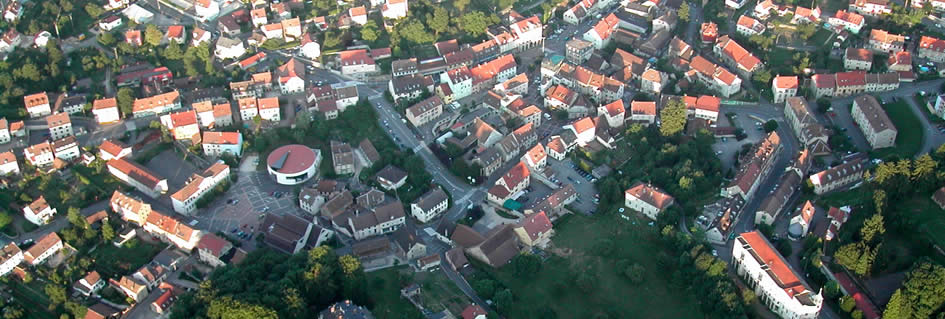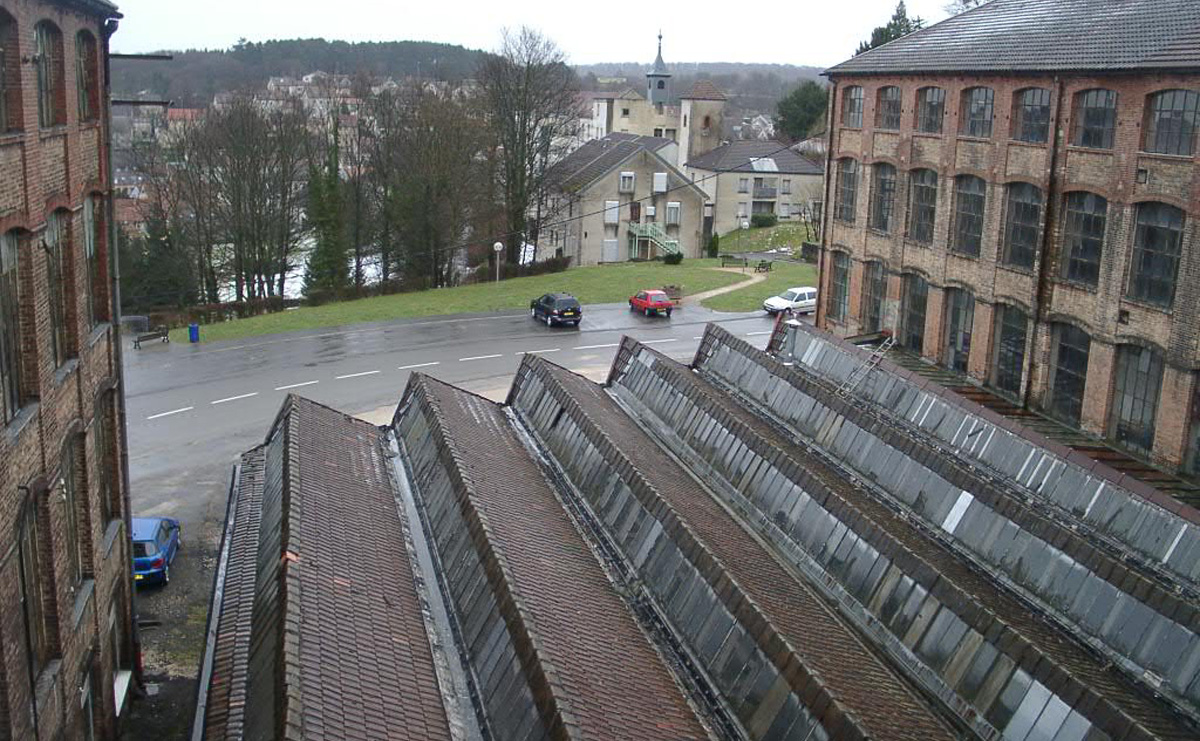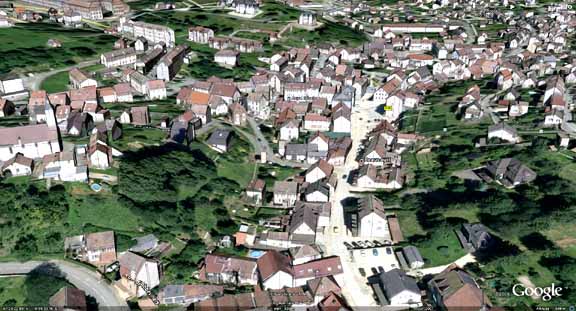Beaucourt
Beaucourt is a town in the French department of Territoire de Belfort in the Franche -Comté. It is the capital of the canton in the Arrondissement Beaucourt Belfort.
Geography
Beaucourt is located at 425 m, about ten kilometers east-southeast of the town of Montbéliard (air line). The community extends into the northern foothills of the Jura Mountains, in a depression in the Tabular Jura plateaus, at the northern foot of Grammont, near the border with Switzerland.
The area of 4.95 km ² municipal area includes a portion of the northern French Jura. The central part of the area is occupied by a small valley to the south of the historic town center, takes its beginning and opens up to the valley of the village of Dampierre Bach to the north. The approximately 200 m wide, flat Talniederung located at about 420 m and is flanked on both sides by about 20 to 30 m high slopes. This lead on to the adjacent plateaus that are on average 450 m. They are largely built over. In the west the boundary runs above the pan of Dasle and along the Bois de Meilloncourt, while the eastern boundary by the steep drop to the valley of Feschotte is highlighted. To the south, the municipality's area extends over a forested slope up to the plateau of Grammont, on the 575 meters, the highest elevation of Beaucourt is achieved.
To Beaucourt include the hamlets and settlements:
- Cité P. Japy (450 m) at the height west of the town center
- Cite Ducrot (400 m ) in the lower ( northern ) part of the basin of Beaucourt
- Cité A. Japy (440 m) on the plateau east of the valley of Beaucourt
- Cite Bellevue (462 m) on the plateau east of the valley of Beaucourt
Neighboring communities of Beaucourt are Dampierre -les -Bois in the north, Badevel and Saint-Dizier -l'Évêque in the east, the south and Montbouton Dasle in the West.
History
The territory of Beaucourt was settled very early. On the plateau of Grammont was in a fortified Neolithic settlement site in which several tumuli were found. During Roman times, the traffic route of Epomanduodurum ( Mandeure ) led to Augusta Raurica through the territory of Beaucourt.
For the first time Beaucourt is mentioned in records in 1147. Since the Middle Ages, the city was at the limit of the Archdiocese of Besançon and the Prince-Bishopric of Basel. Beaucourt belonged first to Elsgau, since the beginning of the 14th century to the reign dent. In the first half of the 14th century the village came under the suzerainty of the Habsburg dynasty. Together with the Sundgau Beaucourt came with the 1648 Peace of Westphalia to the French crown. Since 1793 Beaucourt belonged to the Department of Haut -Rhin, however, remained in 1871, unlike the rest of Alsace as part of the Territoire de Belfort in France.
The local and industrial history of Beaucourt is closely connected with the family Japy. This strain is traced back to the 16th century. Frédéric Japy, born in 1749 the son of a blacksmith, learned in the Swiss town of Le Locle in the occupation of watchmaker. Back in Beaucourt he built machines and tools for the serial production of accessories for the watch industry. The first factory was opened in 1777. It led to a rapid economic upswing end of the 18th century. Thus, the first workers' settlements, studios, homes, schools and shops for daily needs arose included. During the 19th century, industrialization further progressed greatly. During the peak of after the middle of the century up to 5000 people were employed in the factories. Production was moved from the original watches to manufacture numerous other articles extended: Hardware, lamps, tools, agricultural implements. The Japy family of industrialists shaped the townscape Beaucourt with the factories, their own " castles " and the villas built and donated a church.
With the opening of the railway line Montbéliard Morvillars on June 29, 1868 Beaucourt was connected via the railway station Dasle - Beaucourt to the French rail network; a tramway led 1904-1938 from the station to the town center. Passenger traffic on the railway line was set in 1938, the last freight train in the direction Morvillars perverted, 1969; the disused section was completely removed. From Audi Court of goods traffic was stopped in 1990, the remaining distance was locally degraded and is no longer passable.
The decline of the Japy factories began around 1870. 's Why the industry is diversified further, because of the traditional branches of production were new production of pumps, electric material, household articles (especially cooking pots) and typewriters ( from 1910 until 1975) added. During the 20th century, the traditional industry has been increasingly supplemented and replaced by new factories. 1970 Beaucourt was capital of the newly created canton of the same. Today, the community is part of the community association Communauté de communes du Sud Territoire.
Attractions
The Catholic church of Saint Francis was built in the 19th century. Also from the 19th century comes the Reformed Church ( south of the town center ). The site of Beaucourt is dominated by the buildings of the industrial family Japy: old industrial buildings ( Pendulerie ), former workers' settlements and a total of 13 locks that were built in the 19th century for the different members of the family. Worth seeing is the Musée Frédéric Japy, in which the local industrial history of the 18th and 19th centuries (especially the watch industry ) is shown.
Population
With 5106 inhabitants ( 1 January 2011) Beaucourt is one of the largest municipalities of the department of Territoire de Belfort. During the 19th century, the population in the course of industrialization showed rapid growth. With almost 4600 inhabitants of the provisional maximum level was reached in 1900. Then followed a period of stagnation and after 1930 a decline of 16%. Significant growth (33%), especially in the period 1955-1975 was recorded again. With approximately 5700 inhabitants, the previous high was reached at the beginning of the 1980s. Since then, the population has declined slightly again. Until 1999 Beaucourt lost a little more than 300 people, representing a decrease of 6%. The settlement area of Beaucourt has grown together today almost completely with those of Dasle and Dampierre -les -Bois.
Economy and infrastructure
Early as the late 18th century Beaucourt developed into an industrial site. The industrial and commercial areas of focus it on the valley north of the town center and on the plateau west. Important employer of the place is the Alsthom - Unelec that manufactures electric motors and about 300 people are employed. There are also numerous smaller companies in the areas of micro-mechanics, metalworking, production of car accessories, electronic industry and surface treatment. In addition, there are various companies which are active in the service sector, a supermarket and many other stores of retail trade for their daily needs. Beaucourt is the site of a College. As a cultural center, the Foyer Georges Brassens serves. Thanks to the attractive residential location, Beaucourt also developed into a residential community for the agglomeration of Montbéliard.
The village has good transport links. It lies on the secondary road D126 which leads from Audi Court to Delle. The nearest links to the A36 motorway is located at a distance of about eleven miles. Further road links exist with Dampierre- les- Bois, Saint- Dizier- l'Évêque and Montbouton. With Audi Court and the City of Montbéliard Beaucourt is connected by a bus.









